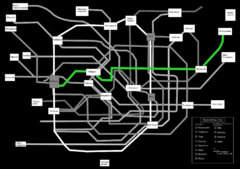
Back Toei Shinjuku-Linie German Linio Ŝinĵuku (Metroo Toei) EO Línea Toei Shinjuku Spanish خط شینجوکو FA Toein Shinjuku-linja Finnish Ligne Shinjuku French Linea Shinjuku Italian 都営地下鉄新宿線 Japanese 도에이 지하철 신주쿠선 Korean Linha Shinjuku Portuguese
| Toei Shinjuku Line | |
|---|---|
 | |
 A Toei Shinjuku Line 10-300 series train | |
| Overview | |
| Other name(s) | S |
| Native name | 新宿線 |
| Owner | |
| Line number | 10 |
| Locale | Tokyo, Chiba prefectures |
| Termini | |
| Stations | 21 |
| Color on map | Chartreuse (#B0C124) Leaf Mantis green (#6CBB5A) |
| Service | |
| Type | Rapid transit |
| System | Tokyo subway |
| Operator(s) | Toei Subway |
| Depot(s) | Ojima |
| Rolling stock | Toei 10-300 series Keio 9000 series Keio 5000 series |
| Daily ridership | 745,889 (2016)[1] |
| History | |
| Opened | 21 December 1978 |
| Technical | |
| Line length | 23.5 km (14.6 mi) |
| Number of tracks | Double-track |
| Track gauge | 1,372 mm (4 ft 6 in) |
| Minimum radius | 167 m (548 ft) (Between Jimbōchō and Ogawamachi) |
| Electrification | 1,500 V DC (overhead line) |
| Operating speed | 75 km/h (47 mph) |
| Signalling | Cab signalling, closed block |
| Train protection system | JR East D-ATC |
| Maximum incline | 3.5% |
The Toei Shinjuku Line (都営地下鉄新宿線, Toei Chikatetsu Shinjuku-sen) is a rapid transit line in Tokyo and Chiba Prefecture, Japan, operated by Tokyo Metropolitan Bureau of Transportation (Toei). The line runs between Motoyawata Station in Ichikawa, Chiba in the east and Shinjuku Station in the west. At Shinjuku, most trains continue as through services to Sasazuka Station on the Keiō New Line, with some services continuing to Hashimoto Station in Sagamihara, Kanagawa via the Keiō Line and the Keiō Sagamihara Line.
On maps and signboards, the line is shown in the color leaf green. Stations carry the letter "S" followed by a two-digit number inside a yellow-green chartreuse circle.
- ^ 東京都交通局ホーム - 経営情報 - 交通局の概要 - 都営地下鉄 [Tokyo Metropolitan Bureau of Transportation Home - Management Information - Overview of the Department of Transportation - Toei Subway] (in Japanese). 東京都交通局 [Tokyo Metropolitan Bureau of Transportation]. Retrieved 25 October 2018.
